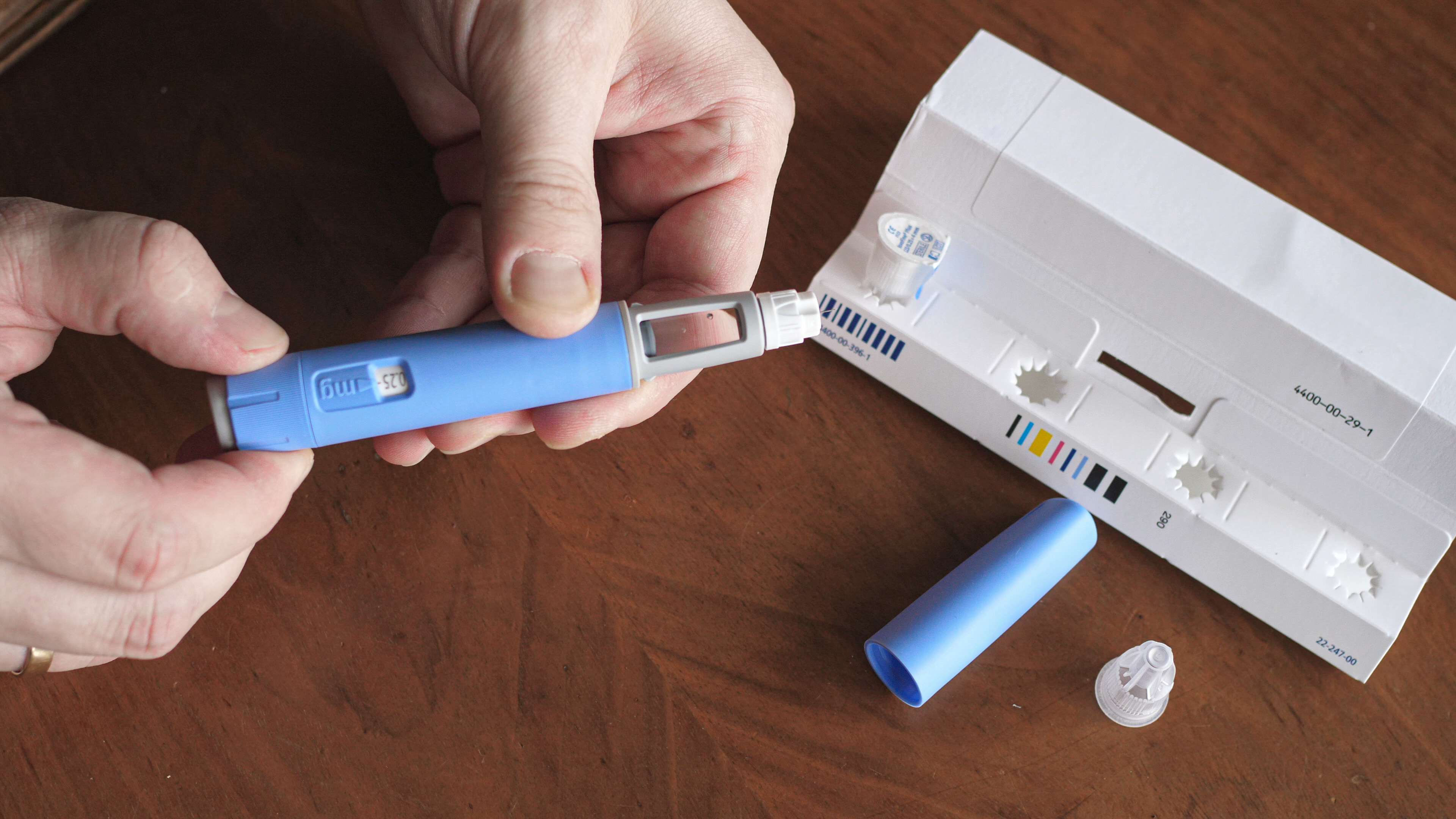Zepbound vs Mounjaro vs Ozempic: Which is best?
Key Takeaways
- Zepbound and Mounjaro share the same active ingredient, tirzepatide, but Zepbound is FDA‑approved for chronic weight management (including obesity and obstructive sleep apnea), while Mounjaro is approved for type 2 diabetes
- Ozempic contains semaglutide and is FDA‑approved for type 2 diabetes (and now chronic kidney disease)
- Tirzepatide (in both Zepbound and Mounjaro) has been shown to cause more weight loss than semaglutide (Ozempic) in trials. Prices for these medications can vary based on insurance status and whether or not there is a cash-pay option available for self-pay patients.
Curious about the buzzy new weight loss medications featured all over your social feeds? Over the past few years, GLP-1 and GIP medications like Mounjaro (tirzepatide), Zepbound (tirzepatide)and Ozempic (semaglutide) have been making waves.
In this blog, we'll dive into the differences in how Mounjaro, Ozempic and Zepbound work. We’ll also discuss their specific Food and Drug Administration (FDA) approvals, side effects and costs.
What is Zepbound?
Zepbound is an injectable medication that’s FDA-approved to treat obesity in adults. It's also approved to treat obstructive sleep apnea (OSA) in adults with obesity. Zepbound is made by pharmaceutical company Eli Lilly, and contains the active ingredient tirzepatide. Tirzepatide is also found in Mounjaro, a type 2 diabetes drug that is also made by Eli Lilly.
Tirzepatide belongs to a class of drugs called dual glucose-dependent insulinotropic polypeptide (GIP) and glucagon-like peptide-1 (GLP-1) receptor agonists.
The dual action of GIP and GLP-1 affects blood sugar and food intake in multiple ways, including:
- Prompting the pancreas to release insulin when blood sugar levels are high
- Decreasing the release of glucagon, which aids in lowering blood sugar levels
- Slowing the process of stomach emptying, aiding in appetite control and reducing food consumption
- Encouraging a feeling of fullness following meals
Zepbound comes in the form of a pre-filled pen with a needle on the end. It’s given to patients as a subcutaneous injection (delivered just under the skin) once a week.
What is Mounjaro?
Mounjaro is another brand name for the medication tirzepatide. Tirzepatide is the same active ingredient in Zepbound. However, Mounjaro was approved by the FDA in May 2022 to treat type 2 diabetes. Zepbound, on the other hand, is approved for weight management.
Like Zepbound, Mounjaro is manufactured by the pharmaceutical company Eli Lilly. It belongs to the GIP/GLP-1 class of medications as well.
Mounjaro, which is also administered as a weekly injection, works just like Zepbound. It helps the pancreas to control how much insulin is released. It also slows down food absorption to make you feel more full and reduce how much you eat.
In general, higher doses of tirzepatide have been shown to affect body weight. However, it’s indicated for diabetes management - not weight loss. In other words, weight loss is a side effect of Mounjaro. But prescribing it for weight loss is an off-label use of the medication.
What is Ozempic?
Ozempic is the brand name for semaglutide, an injectable medication made by Novo Nordisk. The FDA has approved Ozempic to manage blood sugar levels in patients with Type 2 diabetes. It was also approved in 2025 to treat chronic kidney disease in diabetic patients.
Semaglutide belongs to a class of medications called glucagon-like peptide receptor agonists, better known as GLP-1s. It is slightly different from GLP-1/GIP medications like Mounjaro and Zepbound.
GLP-1 (glucagon-like peptide-1) drugs mimic the action of GLP-1, a natural hormone produced in the intestines. When you eat, GLP-1 is released from your intestines. It signals the pancreas to release more insulin, a hormone that lowers blood sugar levels.
Insulin helps glucose (sugar) in your bloodstream enter cells, where it can be used for energy or stored for later use. GLP-1 ensures that insulin is released when needed, such as after a meal when blood sugar levels rise.
GLP-1 also reduces the release of glucagon, another hormone produced by the pancreas. Glucagon has the opposite effect of insulin. It raises blood sugar levels by signaling the liver to release stored glucose into the bloodstream. By inhibiting glucagon, GLP-1 helps prevent excessive glucose release from the liver. This is important - too much glucose being released at once can lead to high blood sugar levels.
Medications like Ozempic, Zepbound and Mounjaro also help slow down the emptying of the stomach. This helps to control the rate at which carbohydrates from your meal enter the bloodstream. This gradual release of nutrients can prevent rapid spikes in blood sugar levels after eating.
Ozempic doesn't just help to regulate blood sugar levels. It helps adults with type 2 diabetes and heart disease to reduce their risk of major cardiovascular events like heart attack or stroke. It also reduces the risk of severe kidney problems in diabetic patients with chronic kidney disease.
Ozempic is available in several dosages and is given to patients as a once-weekly injection.
What is the difference between Zepbound, Mounjaro and Ozempic?
Mounjaro and Zepbound have the same active ingredient: tirzepatide. However, Mounjaro has been approved as a treatment for type 2 diabetes, while Zepbound is approved for weight loss.
Ozempic, on the other hand, has a different active compound (semaglutide). Ozempic is categorized as a GLP-1 receptor agonist instead of a GIP/GLP-1 receptor agonist, like Zepbound and Mounjaro.
In a head-to-head trial of semaglutide and tirzepatide, tirzepatide was superior in weight loss outcomes. At the highest doses, users of tirzepatide lost about 12 additional pounds compared to those using semaglutide (about 5.5kg).
Who are these medications recommended for? Are there people who should not use them?
The evidence for the efficacy of these medications is strong, but they are not without side effects and some risks. Patients will require physician’s guidance - and most likely blood work - to monitor their body’s response to the medication over time.
Clinicians will usually only prescribe these medications like Zepbound, Mounjaro and Ozempic if your body mass index (BMI) is 30 or higher (27 or higher if it's accompanied by weight-related medical conditions such as high blood pressure, heart disease, type 2 diabetes, pre-diabetes, high cholesterol, non-alcoholic fatty liver disease, obstructive sleep apnea or PCOS).
These medications are not indicated for people with any of the following conditions:
- A history of pancreatitis. It’s suggested that GLP-1 agonists are associated with an increased risk for pancreatitis and pancreatic cancer.
- A personal or family history of certain thyroid cancer. Both tirzepatide and semaglutide have a ‘boxed warning’ from the FDA. This is due to the rare but serious risk of developing thyroid tumors from this medication.
- A slow digestive system. GLP-1 agonists work in part by slowing motility. Motility is a term for how fast your gastrointestinal tract moves food through your body. This makes you feel full for longer, but also can increase the risk of GI issues. Use of these drugs was linked with a 4.22- and 3.67-times higher risk for bowel obstructions and gastroparesis, respectively.)
For these reasons, you should have an in-depth conversation with your doctor about your medical history before considering weight loss medication. This includes any allergies or other conditions that you may have. You should also have an extensive dialogue about the medicines or supplements that you're currently taking. Be sure to bring up if you are pregnant, breastfeeding or planning to get pregnant soon.
What's the cost difference between Zepbound, Ozempic and Mounjaro?
Costs are largely dependent on your insurance status. If you’re insured, the price of these medications depends on the rates negotiated by your insurer. If you're not insured (or if your insurance doesn't cover your medication), cash prices can range from $349/mo to $1,200 per month depending on the medication.
Here’s what prices look like without insurance coverage:
- Ozempic (semaglutide) usually costs between $850-$1,000 per month before insurance, but it can also be accessed at a reduced cash price of $349 per month via Novo Nordisk's direct-to-consumer online pharmacy.
- Zepbound (tirzepatide) pens cost around $1,060 per month before insurance. However, Eli Lilly also manufactures Zepbound vials, which have the same ingredient as Zepbound pens but come in a different injection form. These vials are exclusively for self-pay patients through Lilly's direct-to-consumer pharmacy, meaning they are not available through insurance. A one-month supply of 2.5 mg Zepbound vials is priced at $349, while doses from 5 mg to 15mg are priced at $499 per month.
- Mounjaro (tirzepatide) usually costs between $1,020 to $1,200 per month before insurance. Eli Lilly does not currently offer a lower cash-pay price for this medication.
Doctors, including those at Sesame, can help patients compare price and medication options. They can also assist with insurance prior authorization requests for prescription coverage. Plus, they can direct you to medication savings coupons from manufacturers to assist with medication costs!
How Sesame can help
Sesame offers an affordable and comprehensive online weight loss program to help you get started on your weight loss journey. Success by Sesame is a month-to-month subscription that includes a video consultation with a weight loss doctor or specialist of your choice, access to prescriptions for weight loss medication if appropriate, unlimited messaging with your provider, ongoing support, and more.
Maintaining a healthy weight can lead to significant health benefits, including a lower risk of heart disease, improved mobility, better sleep, and enhanced overall well-being. Get started on your weight loss journey today. Note that all prescriptions are at the discretion of your healthcare provider.
Related posts

Compare the effectiveness, side effects and prices of weight loss and diabetes medications Mounjaro and Wegovy.

As a result of drug shortages and high prices, many people are exploring Ozempic alternatives. To make your search easier, we’ve detailed every GLP-1 on the market below – along with a comparison of cost, dosing amount and how it varies from Ozempic.

This article will examine how effective Mounjaro is as a weight loss drug, how it works, and what to consider before taking it.

The FDA ended the semaglutide shortage on Feb 21, 2025. Learn key deadlines for compounded semaglutide, GLP-1 alternatives and more.

Comparing the effectiveness of popular semaglutide medications Ozempic and Wegovy for diabetes and weight loss. Learn about cost, eligibility and more.

Zepbound (tirzepatide) is FDA-approved to treat obesity. Learn more about this weight loss medication, including how it works and how to use it.

Mounjaro is effective but expensive, with a retail price of $1,069.08 per month from Eli Lilly. Read on for details on its cost with and without insurance and tips for saving on your prescription.

In June 2024, a generic version of Victoza (liraglutide) became available to the public. This is the first authorized generic GLP-1 drug to hit the market. Here's what you need to know.

In this article, we’ll investigate the differences between types of pharmacies and what role compounded medications play in our national healthcare system.
